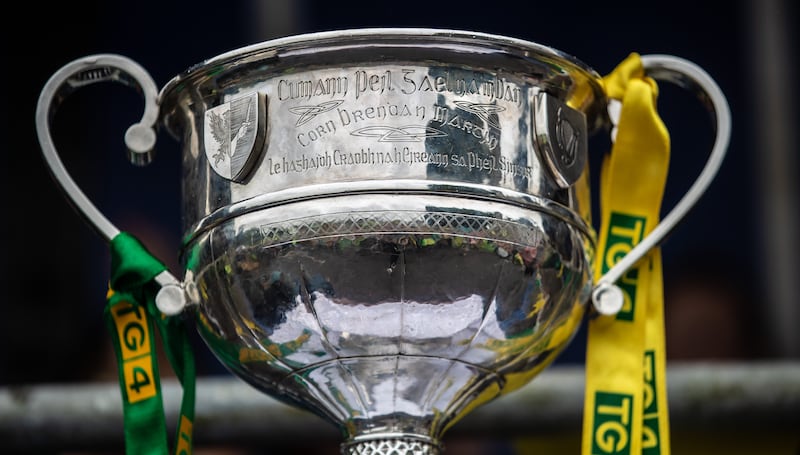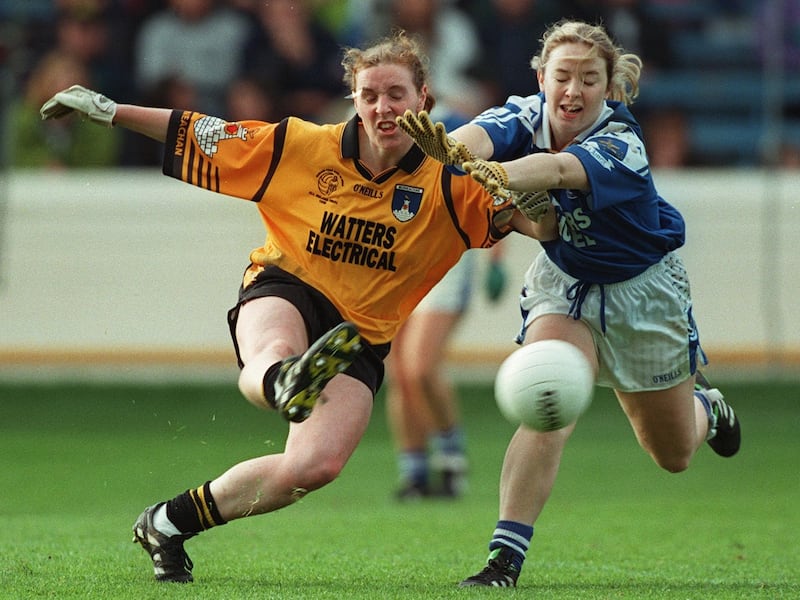Kitty Ryan laughs at their innocence, and the fun they had.
Tipperary reached the first All-Ireland women’s football final and for training they wangled access to Rockwell College, with its lush carpets of grass and hospitable dressing rooms.
“After training,” says Kitty, “we used to jump into the swimming pool, still wearing our togs and jerseys.”
Mad-giddy, like American students on spring break.
RM Block
The final against Offaly was played in Durrow, on October 13th, 1974. Kitty’s club Ardfinnan were the county champions and they had nine players on the panel. In the small convoy of cars that left the village that morning Kitty travelled with the parish priest, maybe because she was captain.
The game was a cliffhanger, deadlocked at 2-2 apiece deep in the second half. Tipp found a winner, though, and Kitty was stuck in it.
“The match was nearly over and I was thundering in with the ball,” she says, “and there was this one behind me, very, very close. And sometimes if there’s somebody too close to you, you can’t kick the ball. And I knew the referee was a good bit back because he was a bit slow on his feet I’d say. I kind of done a bit of a dive. He didn’t see it at all. We got the free and we won the match.
“It just came into my head, ‘I’ll have to do something.’ I was getting desperate. Time was nearly up. So, what do you do? Isn’t that what you do? I wouldn’t get away with it today, would I? The umpires would have collared me.”
A man called Brendan Martin sponsored the cup, and in a unique ceremonial twist, the losing captain, Agnes O’Gorman, presented it to Kitty. That tradition only lasted a year. No more than a couple of hundred people had turned up in Durrow. Glory doesn’t need a crowd.

“After the match we went to the hotel [in Durrow] and we were all excited – you can imagine now, 50 years ago, getting a meal in a hotel. The homecoming was brilliant. We came over the bridge in Ardfinnan in a tractor and trailer and the village was packed with people. They suddenly realised what we had achieved.”
Beyond their circle not many people noticed. The Tipp senior hurling final was staged on the same day. None of the local papers sent a reporter to Durrow.
The Tipp PRO rustled up half a dozen paragraphs that were carried, word-for-word, in the Tipperary Star and The Nationalist, buried on their sports pages under the weight of familiar topics. The Nenagh Guardian let it pass, unrecorded.
The only national newspaper to cover the match was The Irish Press, not with a match report but with a front page colour piece and a picture of Kitty, holding the cup and being carried shoulder-high.
“With a bit of luck,” wrote Dan Coen, “more than eight counties will take part in next year’s championship, and the final will be played in Croke Park.”
It would be another 12 years before Croke Park played host to an All-Ireland women’s football final, and a further 12 years after that before a final was televised live on TV.
Tomorrow the 50th final will draw a crowd of at least 50,000 to Croke Park, and an audience reach of over half a million people on TG4, if the trend of recent years continues. There is no reason to expect otherwise; all of those numbers are rooted and robust now.
In living memory, the All-Ireland final has been transformed from a niche curiosity in the Gaelic games calendar into the most successful event in the landscape of Irish women’s sport. None of that was bound to happen, and none of it happened quickly.
Michael Ryan was the Waterford manager for 24 years and he went to his first final 40 years ago. Kerry and Wexford met in Kilsheelan, in Co Tipperary and after a decade of finals nothing much had changed.
“It was a very sparse crowd,” he says. “It was like the crowd you’d see at a GAA challenge match. There was very little interest in it. No media attention. No nothing. It was as if the world passed by.”
As the game grew and the championship expanded, the All-Ireland final needed the reflected status of a marquee venue. In 1985, the LGFA secured Páirc Uí Chaoimh for their showpiece match; a year later, they were in Croke Park.
The camogie final had started a residency there in the early 1950s – having first staged finals in Croke Park as far back as the 1930s – but camogie had a much longer history and in women’s Gaelic games, it was the establishment sport. Women’s football was a start-up, in need of visionary investors.
Waterford were a junior team in 1986 and on the day women’s football took its first bow in Croke Park they played in the curtain-raiser.
“The attendance,” says Ryan, “was about 3,100, but it was all about the players out on the pitch. It was about getting your foot inside the gate.”
Just like so many women’s sports, visibility was a massive issue. Growing up in Mayo, Cora Staunton was football-mad, but idols were more readily available elsewhere. She played on the Mayo team that won an All-Ireland in their first appearance in the final in 1999, but before that she had never been to a women’s final, or seen one. It didn’t even cross her mind.
“People say to me, ‘Did you have any people you looked up to in the ladies game?’ and I didn’t,” says Staunton. “I would have had no idea at all. I never saw ladies football on television when I was younger. I always thought I was going to be a Manchester United soccer player because all I ever watched was Roy Keane and Man United. I never thought I was going to be a Mayo footballer.”
In a few years, around the turn of the century, the game caught a wave and surfed it. The first All-Ireland final shown on television in 1998 turned out to be a classic. Waterford and Monaghan had been two of the dominant teams of the previous decade and they played out a high-scoring draw; the replay generated even more attention.

“That elevated the sport to a new status,” says Ryan. “Waterford and Monaghan captured the attention of the nation and, more than any other single fixture, that catapulted the whole thing forward.”
A year later Mayo landed in Croke Park with a huge following. For five years in-a-row they contested the final. When that sequence ended in 2003, 30,000 were in Croke Park to witness Mayo beat Dublin with a late goal. Further up the mountain, this was a new base camp.
“Even for us, going into the final in 1999,” says Staunton, “we wouldn’t have been used to any crowds at our games at all.”
For attendances, the All-Ireland final became the outlier. The other rounds of the championship would only be attended by a fraction of the Croke Park crowd. That remains the case.
What the games still needed was exposure. Helen O’Rourke had been appointed as chief executive of the LGFA in 1997 and she pushed RTÉ for more live coverage. In an interview with Malachy Clerkin two years ago, she described a fraught meeting with the late Tim O’Connor in 1998, when he was head of sport.
“Everything was such a struggle,” said O’Rourke. “The battle you had to go through to get the semi-finals shown – there just wasn’t the interest there [in RTÉ]. Tim said to me, ‘The people of Ireland would have more interest in televised tiddlywinks than watching women play football.’”
O’Connor relented, though, and RTÉ agreed to show semi-finals and finals, but the arrangement didn’t last long. Bank of Ireland pulled out as the championship’s headline sponsor and the LGFA needed a replacement. In TG4 they found a life partner.
“Helen was looking for a sponsor,” says Ronan Ó Ciosdealbha, TG4′s head of sport, “but she was also looking for a broadcaster. We were lucky to be in the right place at the right time. If you look at it, in 2001 TG4 had only been on air for five years. We were a very young channel. It was good for us to get involved with ladies football because they were growing, we were growing, and I kind of feel like we grew up together.”
In 2001, TG4 broadcast the semi-finals and finals; a year later they doubled their output and every year since their investment has grown.
This year, they’ve shown more than 30 matches, some of them on their YouTube platform, but most of them on their terrestrial channel. Over the last 20 years or more their relationship with women’s football has been transformative.
“TG4 picked up the product when it wasn’t fashionable,” says Ryan. “People might have wanted to show the finals, but not a first-round match, or a league game. They’ve done all that. Whatever they get from it wouldn’t repay them for the efforts they’ve put in.”
Tonight TG4 will broadcast a 90-minute preview show with field reports from the six counties competing this weekend. Tomorrow, their live broadcast from Croke Park will run to nearly seven hours. Their commitment has been unflinching.
All of the living captains from the other 49 senior finals will be guests of the LGFA in the Croke Park Hotel tonight and will be introduced to the crowd today. Kitty first. Standing for the groundbreakers. When nobody knew and nobody wondered.





















